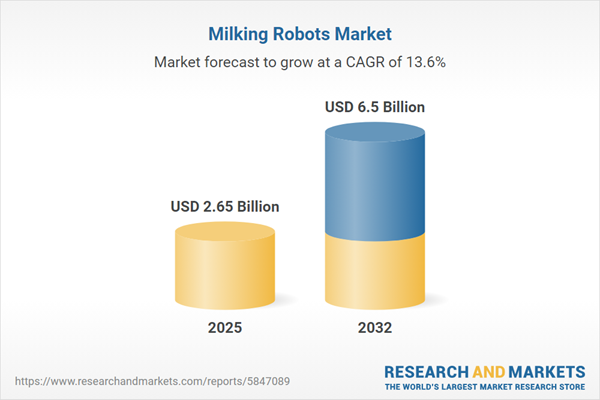Speak directly to the analyst to clarify any post sales queries you may have.
The milking robots market is rapidly reshaping dairy operations, driven by automation trends, digital transformation, and the increasing importance of sustainable practices. Senior leaders now face a changing landscape where strategic adoption of advanced technologies is essential to maintain competitive edge and ensure long-term operational resilience.
Market Snapshot: Milking Robots Market Size and Growth
The global milking robots market is on a robust growth trajectory, rising from USD 2.34 billion in 2024 to USD 2.65 billion in 2025 and projected to reach USD 6.50 billion by 2032, with a strong compound annual growth rate of 13.59%. Growth is underpinned by widespread adoption of automation, demand for consistent productivity, and a sharpened focus on animal welfare. Platform modernization, evolving supply chain strategies, and dynamic policy support are impacting how industry participants—from new entrants to established leaders—develop innovation initiatives and market approaches. Across the Americas, Europe, and Asia-Pacific, modernized dairy operations are emphasized as a path to industry leadership.
Scope & Segmentation
This report delivers a comprehensive analysis of the automated milking robots environment, guiding stakeholders to align technology investments and operational priorities with industry trends and compliance requirements. Multifaceted segmentation informs strategic decisions at both regional and corporate levels.
- Product Type: Arm robots and cabin robots are driving operational efficiency and elevating standards of animal care across diverse dairy setups.
- System Type: Options including lateral, parallel, and rotary systems accommodate both legacy and contemporary farm structures, supporting a broad spectrum of herd management practices.
- Herd Size: Adaptable automation solutions target large, medium, and small herds, enabling flexibility for independent farms and consolidated agribusinesses alike.
- Distribution Channel: Dealer networks, direct sales teams, and digital platforms extend access, strengthen aftersales support, and influence technology deployment timelines.
- Component: Essential hardware—such as actuators, controllers, and sensors—integrates seamlessly with maintenance and analytics offerings, assisting with operational continuity and improved decision-making.
- Installation Type: Greenfield and retrofit installations—accommodating single and multi-stall formats—enable both new facility implementation and modernization of current infrastructures.
- Regional Coverage: Coverage spans the Americas (United States, Canada, Mexico, selected Latin American markets), Europe, Middle East & Africa (notably Germany, United Kingdom, France, GCC countries, Africa), and Asia-Pacific (including China, India, Japan, Australia, Southeast Asia), analyzing regulatory trends, technology readiness, and investment patterns.
- Key Companies: Industry leaders such as Lely Industries N.V., DeLaval International AB, GEA Group Aktiengesellschaft, BouMatic LLC, Allflex Europe NV, Afimilk Ltd., Insentec B.V., and Fullwood Packo plc are shaping innovation agendas and expanding technological frontiers within the sector.
Key Takeaways
- Automation helps address fluctuating labor availability, enabling stable, high-quality dairy production regardless of workforce challenges.
- Sophisticated sensor networks and real-time analytics are enhancing herd health management, allowing proactive interventions and ongoing optimization of animal well-being.
- Customizable and modular systems provide effective solutions for operations of various sizes and regions, supporting both large-scale enterprises and smaller, independent producers.
- Centralized digital platforms streamline work processes such as milking schedules, feed management, equipment maintenance, and remote oversight, supporting precision agriculture goals.
- Regional drivers differ: while the Americas prioritize labor efficiency, Western Europe focuses on environmental stewardship, and facility upgrades power growth in Asia-Pacific.
- Investment trends highlight the importance of integrating robotics, intelligent monitoring, and sustainability measures to boost market adaptability.
Tariff Impact: Implications for Supply Chains and Cost Structures
Impending US tariffs on imported components from 2025 are leading manufacturers of milking robots to broaden supplier networks and build local manufacturing capabilities. This adaptation introduces additional layers to supplier qualification and risk management processes. Dairy businesses are dedicating greater resources to regulatory compliance and supplier verification, increasing agility as regulatory environments change.
Methodology & Data Sources
This report synthesizes insights from technical manuals, regulatory documents, interviews with suppliers and dairy operators, alongside in-depth reviews of supply chains and regional policy shifts. The multi-source methodology ensures accuracy and supports confident decision-making by executive teams.
Why This Report Matters
- Provides actionable insights across the automated milking lifecycle, enabling effective technology adoption and risk mitigation under diverse global regulations.
- Supports leadership teams in supplier selection, automation implementation, and optimal investment timing to address region-specific operational needs.
- Guides organizational adaptation for both operations and workforce, preparing decision-makers to respond proactively to industry and regulatory trends.
Conclusion
Senior leaders can leverage this report to drive strategic transformation in dairy operations—adopting automation, data analytics, and sustainable methods—to secure competitive advantage within a rapidly evolving market environment.
Additional Product Information:
- Purchase of this report includes 1 year online access with quarterly updates.
- This report can be updated on request. Please contact our Customer Experience team using the Ask a Question widget on our website.
Table of Contents
3. Executive Summary
4. Market Overview
7. Cumulative Impact of Artificial Intelligence 2025
List of Figures
Samples

LOADING...
Companies Mentioned
The key companies profiled in this Milking Robots market report include:- Lely Industries N.V.
- DeLaval International AB
- GEA Group Aktiengesellschaft
- BouMatic LLC
- Allflex Europe NV
- Afimilk Ltd.
- Insentec B.V.
- Fullwood Packo plc
Table Information
| Report Attribute | Details |
|---|---|
| No. of Pages | 191 |
| Published | October 2025 |
| Forecast Period | 2025 - 2032 |
| Estimated Market Value ( USD | $ 2.65 Billion |
| Forecasted Market Value ( USD | $ 6.5 Billion |
| Compound Annual Growth Rate | 13.5% |
| Regions Covered | Global |
| No. of Companies Mentioned | 9 |









